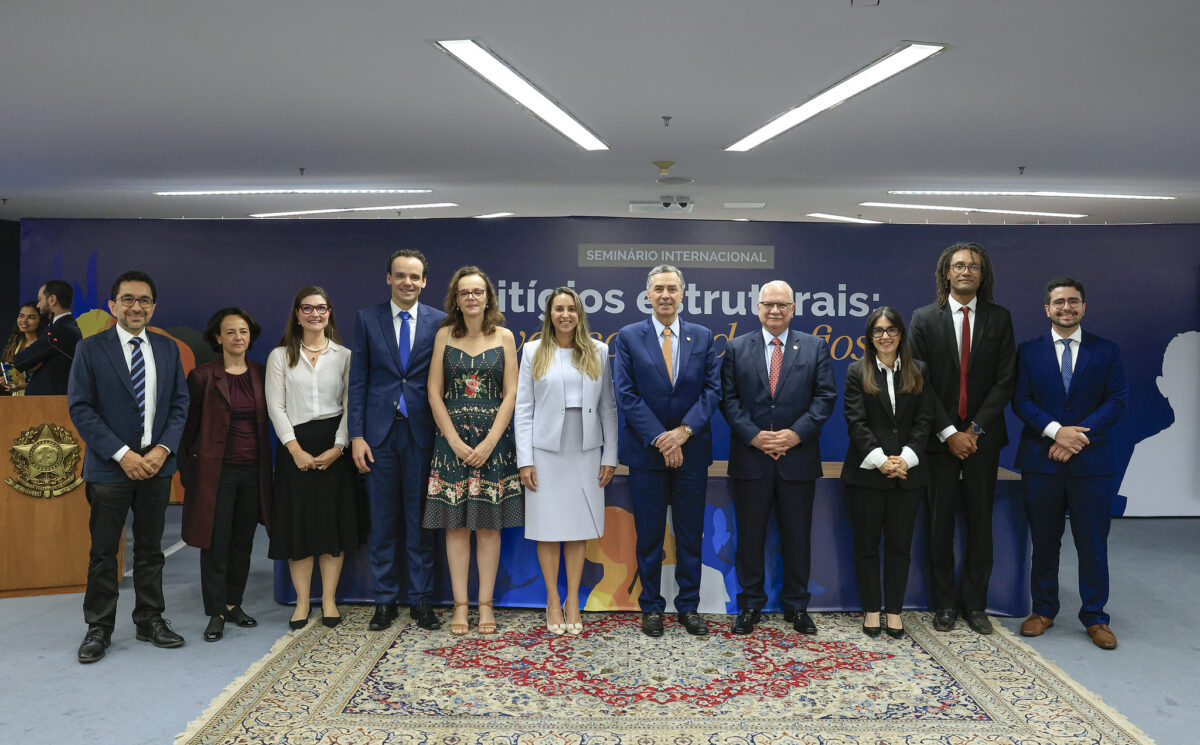EVENTS
MOTH Festival of Ideas & FORGE Gathering at NYU Law
A dynamic week of interdisciplinary exploration, innovation, and collaboration.
The Center for Human Rights and Global Justice hosted a weeklong series of events through the More-Than-Human Life (MOTH) Festival of Ideas 2025 and the Future of Human Rights and Governance (FORGE) Gathering 2025. These global gatherings will bring together thought leaders, advocates, and scholars to explore the most pressing issues of our time, from ecological emergencies to technological disruption to geopolitical shifts. Taking place at NYU Law, this dynamic week of innovation, and collaboration ran from March 10 to March 15, 2025.

Hosted by the Earth Rights Action and Research (TERRA) and the FORGE programs, both gatherings include closed-door, interactive scholar-practitioner sessions, as well as sessions open to the public in the evenings.
With creativity and interdisciplinarity at their heart, the open sessions include keynote talks, interviews, film screenings, book launches, poetry readings, and interdisciplinary performances, concerts, and an exhibit on display throughout the week.
NYU Law is honored to host these pivotal gatherings that bring together bold ideas, diverse voices, and meaningful action. At a time when global justice faces unprecedented challenges, we are committed to fostering a space for creative thinking and forward-looking solutions.
César Rodríguez-Garavito
Chair, Center for Human Rights & Global Justice.
About the MOTH 2025 Festival
The MOTH Festival of Ideas featured thinkers and doers from around the world advancing the rights, interests, and well-being of nonhumans, humans, and the web of life that sustains us all. Practitioners and scholars from a wide range of disciplines—including law, ecology, philosophy, biology, journalism, the arts and well beyond—are pursuing efforts to bring the more-than-human world into the ambit of moral, legal, and social concern. The MOTH Festival of Ideas featured over 100 thinkers and doers at the cutting edge of this rich and rapidly evolving field.
About the FORGE 2025 Gathering
With two days designed to foster a solutions-oriented community of legal experts, social scientists, governance professionals, and community-based practitioners, the FORGE conference is dedicated to uncovering new approaches and solutions that reimagine rights and governance at a critical time for global justice.
With the hope of building momentum toward a brighter future, the MOTH 2025 Festival of Ideas and FORGE 2025 Gathering seek to transform perceptions and inspire a transnational community of practice with new ideas about global justice and more-than-human rights and encourage experimentation with new actions and approaches.
March 10-15, 2025 Schedule of Events
3:00-6:00 p.m. | RSVP via Nina Kantcheva at nina.kantcheva@undp.org
UNDP Headquarters at 304 E 45th St. 11th Fl, NY
Panel: Working with fungi to protect biodiversity and mitigate climate change
- César Rodríguez-Garavito: Professor at NYU Law and founding director of the More-Than-Human (MOTH) Life program.
- Midori Paxton: Director, Nature HUB, UNDP
- Merlin Sheldrake: Biologist, author of Entangled Life: How Fungi Make Our Worlds, Change Our Minds, and Shape Our Futures, and Distinguished fellow at the Center for Human Rights and Global Justice at NYU Law
- Nina Kantcheva: Senior policy adviser on Indigenous Peoples and Local Community Engagement, UNDP (Moderator)
9:00 a.m.-3:30 p.m. | MOTH Festival of Ideas – Academic Conference (closed session)
Breakout rooms at Kimmel Center
Noon-3:00 p.m. | MOTH Festival of Ideas – Exhibit Opening
Greenberg Lounge located inside Vanderbilt Hall at NYU School of Law
The Exhibit will remain on display until March 14 and can be visited from 10:00 a.m. – 8:00 p.m.
4:00 – 7:00 pm | MOTH Festival of Ideas – Public Sessions
Tishman Auditorium located inside Vanderbilt Hall at NYU School of Law
Talk: José Gualinga
José Gualinga: Former Tayak Apu (president) of the Sarayaku Indigenous People and current advisor to the Tayjasaruta (Sarayaku Governing Council); spearheaded the development of the Kawsak Sacha Initiative.
Poetry Reading: Fátima Vélez
Fátima Vélez: Story-teller, professor, PhD candidate, and cultural producer; published the collection of poems Casa Paterna, Del Porno y las babosas, Diseño de Interiores, and the novels Galápagos and Jardín en Tierra Fría; part of Como un Lugar, a collective of Latin American poets based in NYC.
Talk: An exploration of More-Than-Human Rights, César Rodríguez-Garavito
César Rodríguez-Garavito: Professor at NYU Law and founding director of the More-Than-Human (MOTH) Life program.
Poetry Reading: Ezequiel Zaidenwerg
Ezequiel Zaidenwerg: Writer, translator, educator and photographer; published the novels 50 estados: 13 poetas contemporáneos de Estados Unidos and El camino and the poetry collections Doxa and La lírica está muerta.
Conversation: Merlin Sheldrake and Jonathan Watts
Merlin Sheldrake: Biologist and author of the best-selling book, Entangled Life How Fungi Make Our Worlds, Change Our Minds & Shape Our Futures.
Jonathan Watts: Journalist, co-founder of Sumaúma, and global environment editor at The Guardian.
Poetry Reading: Angela Rawlings
Angela Rawlings: Interdisciplinary artist-researcher; author of Wide slumber for lepidopterists, Gibber, o w n, si tu, and Sound of Mull; founder of Snæfellsjökul fyrir forseta (Glacier for president), Iceland’s first rights of nature movement.
7:00 – 9:00 pm | MOTH Festival of Ideas – Art and Performances
Eisner & Lubin Auditorium located inside Kimmel Center
Talk: Sol Guy
Sol Guy: Award-winning producer and director; co-founder of Quiet, an artist-led community based in trust, care, and empowerment; honored by National Geographic as an “Emerging Explorer”; co-produced and directed highly acclaimed projects in music, film, and TV, including: Oscar-nominated film Bobi Wine: The People’s President; the television series 4REAL (MTV/National Geographic); the 2010 World Cup anthem, K’naan’s WAVIN FLAG; and the documentary Inside Out (HBO).
Musical Performance: Eric Terena
Eric Terena: DJ and music producer; amplifies through his music the power of Indigenous ancestrality; currently part of Youth4Climate which, together with other young climate activists from around the world, promotes awareness and actions to reverse the impacts of climate change.
9:00 a.m.-3:30 p.m. | MOTH Fest of Ideas – Academic Conference (closed session)
Breakout rooms at Kimmel Center
4:00-9:00 pm | MOTH Festival of Ideas – Public Sessions
Tishman Auditorium located inside Vanderbilt Hall at NYU School of Law
Conversation: David Gruber and César Rodríguez-Garavito
David Gruber: Marine biologist & Founder & President of Project CETI, an interdisciplinary scientific organization that uses advanced robotics and applied computer sciences to listen to and translate sperm whale communications.
César Rodríguez-Garavito: Professor at NYU Law and founding director of the More-Than-Human (MOTH) Life program.
Poetry Reading: Lila Zemborain
Lila Zemborain: Professor and author of eight poetry collections, compiled in Buenos Aires as Matrix Lux; director and editor of the Rebel Road series and curator of the KJCC Poetry Series at New York University.
Talk: Christine Winter
Christine Winter: Senior Lecturer in environmental, climate change, multispecies, and Indigenous politics at the University of Otago (New Zealand).
Book Launch: Elena Landinez in conversation with Fátima Vélez
Elena Landinez: interdisciplinary artist whose practice explores the relationship between the human and more-than-human.
Fátima Vélez: Storyteller, professor, PhD candidate, cultural producer, and author of the collection of poems Casa Paterna, Del Porno y las babosas, Diseño de Interiores, and the novels Galápagos and Jardín en Tierra Fría.
Poetry Reading: Neronessa
Neronessa: Award-winning poet and social entrepreneur; published the poetry collections La Estirpe de las Gárgolas and El Volcán de la Matriz Electroelástica; participated in over a dozen anthologies and translations in Latin America, Europe and the United States; speaker at the United Nations and NYC Climate Week.
Documentary Screening: All That Breathes followed by Q&A with Shaunak Sen
Shaunak Sen: director of All That Breathes, Grand Jury Prize in the World Cinema Documentary Competition at the 2022 Sundance Film Festival and the Golden Eye award for the best documentary at the 2022 Cannes Film Festival.
9:00 a.m.-3:30 p.m. | MOTH Fest of Ideas – Academic Conference (closed session)
Breakout rooms at Kimmel Center
9:00 a.m.-3:30 p.m. | FORGE Ideas & Actions Discussion Series (closed session)
Greenberg Lounge located inside Vanderbilt Hall at NYU School of Law
4:00-8:00 pm | FORGE x MOTH Festival of Ideas – Public Sessions
Tishman Auditorium located inside Vanderbilt Hall at NYU School of Law
Conversation: Elisa Morgera and Dylan McGarry
Elisa Morgera: UN Special Rapporteur on Climate Change and Human Rights and Professor of Global Environmental Law at the University of Strathclyde.
Dylan McGarry: Co-director of One Ocean Hub and a founding member of Empatheatre.
Remarks: NYU Law Dean Troy McKenzie
Troy McKenzie: Dean and Cecelia Goetz Professor of Law at NYU School of Law.
Arts: Tour of the MOTH Exhibit
Featured artwork by: Elena Landinez, Eli Jacobs-Fantauzzi, Erin Yoshi, Ezequiel Zaidenwerg-Dib, Fátima Vélez, Flora Wallace (ceramicist, ink maker and painter) , and Wio Gualinga (visual artist from the Kichwa Indigenous People of Sarayaku).
Book Launch: Jonathan Watts in conversation with Genevieve Guenther and Andrew Revkin
Jonathan Watts: Journalist, co-founder of Sumaúma, and global environment editor at The Guardian.
Genevieve Guenther: Founder of End Climate Science and author of The Language of Climate Politics: Fossil-Fuel Propaganda and How to Fight It.
Andrew Revkin: Journalist, educator, and author, whose published work includes The Burning Season and The Human Planet: Earth at the Dawn of the Anthropocene.
Conversation: Eliana Hernández-Pachón and Erin Robinsong
Eliana Hernández-Pachón: Writer and educator whose book, The Brush, received the Colombia National Poetry Prize.
Erin Robinsong: Poet, interdisciplinary artist, and author of Rag Cosmology and Wet Dream.
8:00 – 9:30 pm | MOTH Festival of Ideas – Art and Performances
Eisner & Lubin Auditorium located inside Kimmel Center
Concert: Cosmo Sheldrake
Cosmo Sheldrake: UK-based multi-instrumentalist, producer, composer, live improviser, and field recordist; toured internationally with sold-out headline shows across North America, Europe, and Japan; released Wake Up Calls (2020) on his label Tardigrade Records, Wild Wet World (2023), and Eye to the Ear (2024).
9:00 a.m.-3:30 p.m. | FORGE Ideas & Actions Discussion Series (closed session)
Greenberg Lounge located inside Vanderbilt Hall at NYU School of Law
March 14 | 8:00 – 9:30 p.m.
Eisner & Lubin Auditorium located inside Kimmel Center
The MOTH Festival of Ideas concluded with a concert by Cosmo Sheldrake, a UK-based multi-instrumentalist, producer, composer, live improviser, and field recordist.
March 12-15 | 10:00 a.m. – 8:00 p.m.
Greenberg Lounge located inside Vanderbilt Hall at NYU School of Law
The Exhibit featured a range of artists whose work engages with questions essential to understanding and transforming our relationships with the more-than-human world. Featured artwork by: Elena Landinez, Eli Jacobs-Fantauzzi, Erin Yoshi, Ezequiel Zaidenwerg-Dib, Fátima Vélez, Flora Wallace (ceramicist, ink maker and painter) , and Wio Gualinga (visual artist from the Kichwa Indigenous People of Sarayaku).




